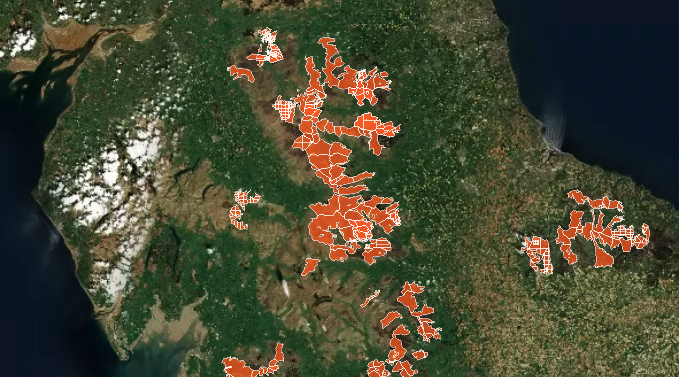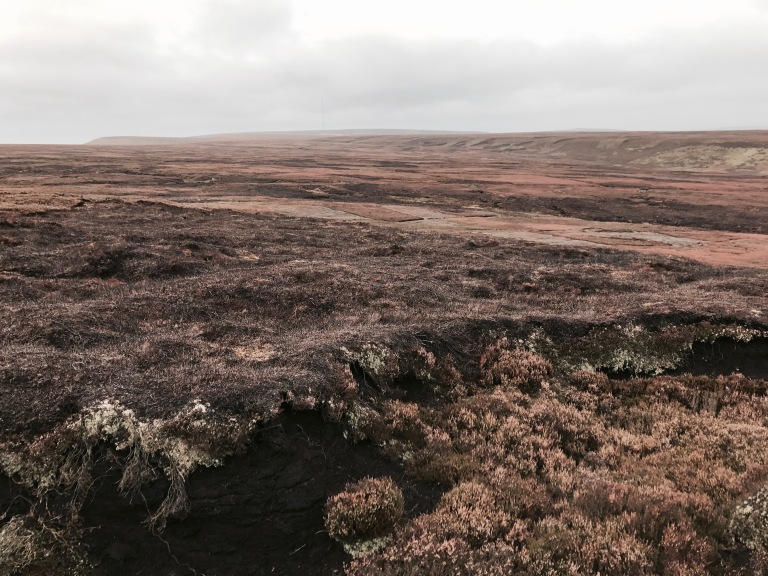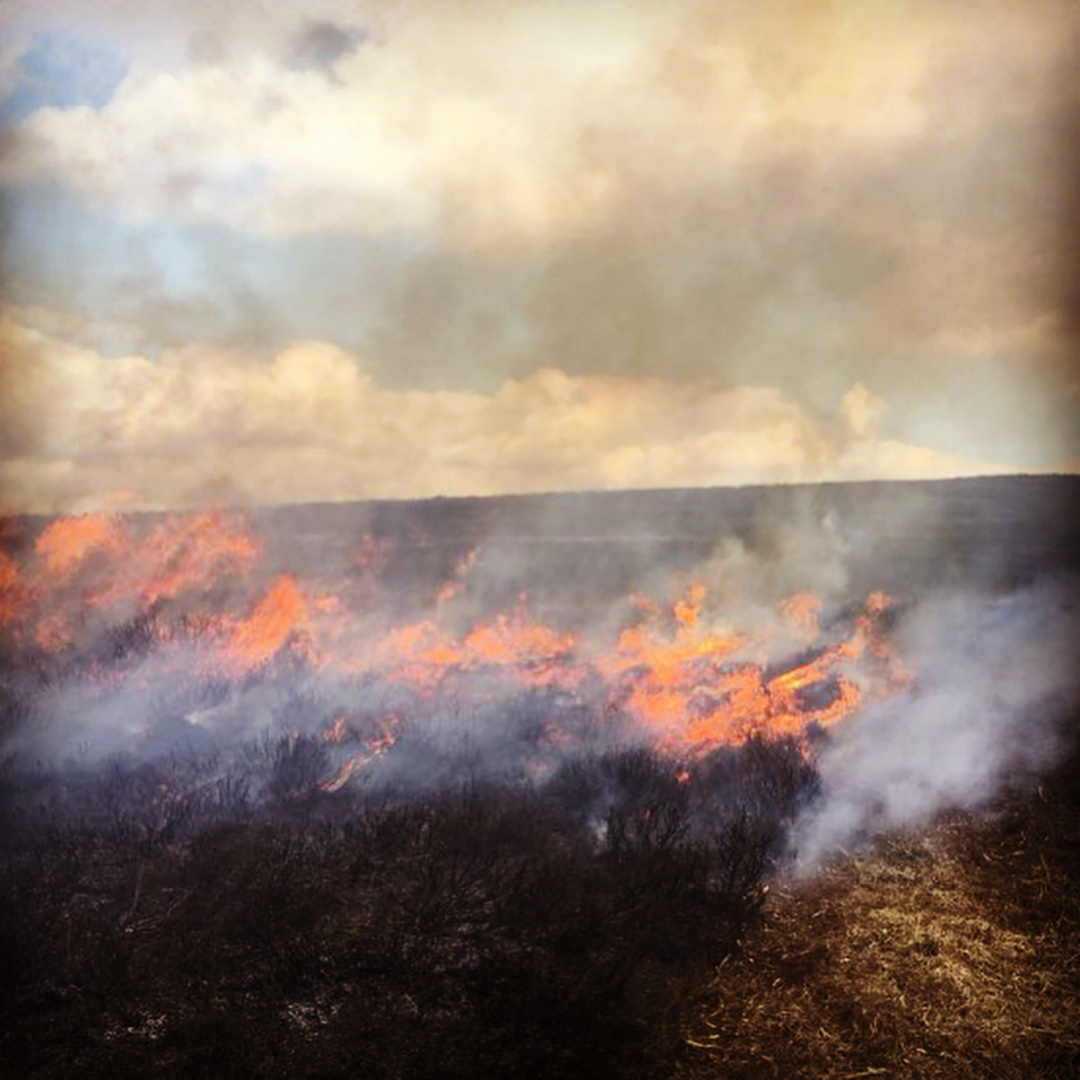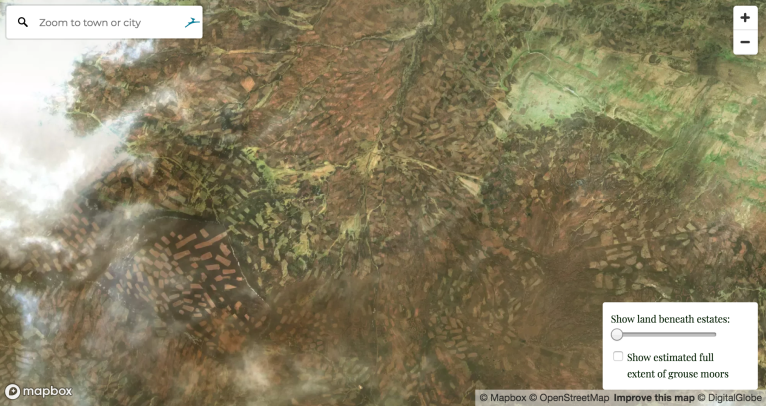This post and investigation by Guy Shrubsole; map by Anna Powell-Smith.
Image: Rotational burning on the Enville Estate, epicentre of the Saddleworth Moor fire.
This Sunday is the ‘Glorious Twelfth’, the start of the grouse shooting season. But who are the landowners who own England’s vast grouse moors?
As Who Owns England has previously exposed, grouse moor estates cover an area of England the size of Greater London – some 550,000 acres – and are propped up by millions of pounds in public farm subsidies.
Now, for the first time, we’ve mapped the owners of around 100 grouse moor estates across England.

Even the Spectator calls owning a grouse moor “screamingly elitist” – and surprise, surprise, around half of England’s grouse moor estates turn out to be owned by the aristocracy and gentry, whilst the other half are owned by wealthy businessmen and women, City bankers, hedge fund managers, and Saudi princes.
Here’s the ten largest grouse moors by area, with their owners, and the farm subsidies their estates received from the taxpayer in 2016:
| Grouse Moor Estate | Acreage | Farm subsidies (2016) | Owner |
| Raby Estate | 30,000 | £683,579 | Lord Barnard |
| Gunnerside Estate | 26,020 | £100,632 | Robert Warren Miller, businessman. Estate registered offshore |
| East Allenheads & Muggleswick | 26,000 | £145,288 | Jeremy Herrmann, hedge fund manager |
| Abbeystead Estate | 23,000 | £57,228 | Duke of Westminster |
| Wemmergill Estate | 15,676 | £272,664 | Michael Cannon, businessman |
| Lilburn Estate | 14,678 | £1,550,699 | Duncan Davidson, founder of Persimmon Homes |
| Bolton Abbey Estate | 13,500 | £139,708 | Duke of Devonshire |
| Bollihope Estate | 12,600 | None registered | Sheikh of Dubai |
| Linhope Estate | 12,000 | Not known | Duke of Northumberland |
| Strathmore English Estates | 11,169 | £279,609 | Earl of Strathmore |
| Totals | 184,643 acres | £3,229,407 |
You can read more about other grouse moor owners and the investigation methodology later in this blog post.
The destructive impact of grouse moors
The fact that a tiny elite owns England’s grouse moor estates matters, because of the disproportionately large environmental impact of managing grouse moors. Grouse moor gamekeepers are responsible for the illegal persecution of hen harriers (we should have 300 pairs in the English uplands – it fell to 4 pairs in 2017), and for wiping out huge numbers of foxes, stoats and other natural predators of grouse.
Moreover, the slash-and-burn practices used to maintain grouse moors – burning heather, often on rare blanket bog – have been shown to dry out and degrade peat soils. This releases soil carbon, adding to global warming, and reducing the resilience of our uplands to the impacts of climate change: desiccated bogs mean worse wildfires when it’s hot (like Saddleworth Moor) and more flooding when it rains (like the flash floods that washed off Walshaw Moor in winter 2015, deluging Hebden Bridge). It also makes grouse moors look like the surface of the moon, as I found on a visit to one in the Peak District:

Our map makes it easy to see the effect of slash-and-burn on a wider scale – you can adjust the transparency of the estates to reveal the patches of burned land beneath. For example, here is a grouse moor in County Durham:
Gove failing to take on the ‘vested interests’ of grouse moor owners
The UK Government is currently subject to legal action initiated by the European Commission, following complaints by the RSPB and Hebden Bridge campaigners for allowing grouse moor owners to degrade protected blanket bog.
Yet as Freedom of Information requests by Who Owns England has revealed, related in today’s Guardian, the Environment Secretary Michael Gove seems content to offer grouse moor owners an easy way out.
At a meeting earlier this year – attended by the Duke of Northumberland, hedge fund manager Jeremy Herrmann, businessman Michael Cannon and others – Gove tried to coax grouse moor owners into taking merely voluntary action, in order to “help the Government demonstrate its intent to the Commission to cease rotational burning on blanket bog”. Attendees were further reassured by Minister Therese Coffey that signing a voluntary commitment to stop rotational burning was “not a legally binding document”.
Previously, Michael Gove has warned that the debate over our post-Brexit landscape risks being “shaped by vested interests who have either the money, or the connections, or the power” to skew policy. There is no finer example of ‘vested interests’ in action than the wealthy, aristocratic owners of grouse moors – who own an area of England the size of Greater London for the pursuit of a sporting hobby – hobnobbing with Ministers who, despite facing infraction proceedings by the EC, are prepared to accept on trust landowners’ voluntary commitment to do better.
Read 1) the meeting minutes here. 2) Draft voluntary commitment here.
Investigating the owners of grouse moors: methodology
My investigation of the owners of grouse moors in England, which Anna has turned into our new map, was painstakingly pieced together from multiple data sources – including estate websites, media reports and the purchase of Land Registry land titles. I’d like to also thank Ruth Tingay for helping me identify various grouse moors. On the map, the major sources are recorded under the ‘Notes’ entry. You can also see the underlying Google spreadsheet here, which also includes some estates not included on the map, as I haven’t been able to track down the estate boundaries.
The estate boundaries are approximate, based on best available data sources – a combination of Environmental Stewardship map polygons and INSPIRE Index polygons (please see the map for full attribution and links to these data sources).
If you notice something you think is inaccurate, or if you can help me fill in the missing estates or have information you’d like to share, please get in touch!
Other noteworthy grouse moor owners
- The Queen, via her Duchy of Lancaster, owns grouse moors in the Forest of Bowland (on her Whitewell Estate) and in the North York Moors.
- A few grouse moors are owned by the water companies Yorkshire Water and United Utilities (who own lots of land in upland watersheds in northern England) – they lease them out to shooting syndicates.
- Some grouse moors in the Peak District are owned by the National Trust, who continue to maintain them – in a variety of different ways – despite members’ concerns (see this blog by Mark Avery on the situation).
- Some parts of the uplands are utterly dominated by grouse moors, like the North Pennines and the North York Moors; other upland areas have escaped the rash, like the Yorkshire Dales, and Cumbria (though the Lakes have their own issues with overgrazing by sheep). No grouse moors exist in England south of the Peak District (though there are other upland areas like Dartmoor, Exmoor and Bodmin Moor).
Take action
The government needs to stand up to the vested interests of the grouse shooting lobby and ban the burn on grouse moors. Come to that, it needs to outlaw driven grouse shooting entirely, as ornithologist Mark Avery and tens of thousands of other people have called for.
Here are some ways you can help take action immediately:
- Support Findlay Wilde’s Thunderclap for this Sunday’s ‘Glorious 12th’.
- Sign this petition urging an end to grouse shooting on Yorkshire Water’s moorland.
- Support Ban the Burn, the Hebden Bridge-based group campaigning for an end to rotational burning by grouse moor owners.
- And please share this blog post and our map!


It’s often said that meat-eaters have no place criticising grouse-shooters. But it’s a curious psychology that shoots for fun. Like domestic tabby cats, the urban aristocracy that kills for sport is a sad wee beastie indeed. In fact if these folk reflected on their behaviour for more than a moment, they’d be so embarrassed: put on 18th century fancy-dress, head out with your side-by-side with a fat old spread, and hose down a bunch of farm-raised chicken. To impress your sad old mates.
LikeLike
The Tories are never likely to do anything about this wanton sacrilege of our wildlife and ountryside, because these landowners and shooters are the people who donate to the Tory elections funds and in effect enable them to dominate Parliaments and run the country. Our so called Democracy is a corrupt system based on bribery!
LikeLike
Well articulated. Without question, this practice will be looked back upon by future generations in utter astonishment and absolute shame. We must keep exposing it and pushing for a ban.
LikeLiked by 1 person
Well said Bob. I’m just home from a walk in the Lammermuir Hills. What a mess the burning has had up there. It would have been a wonderful place for our Scottish honey bees if the heather had been left to bloom. Tom.
LikeLike
I am curious what the official reason for the subsidies are and whether it is justified. That is if it is for maintaining fencing …. can they prove that they spend that much… it’s basic tax logic is ‘t it? …that we do no give them more than they need.
LikeLike
Reblogged this on nearlydead.
LikeLike
We can’t afford to protect the interests of a few who are hell bent on destroying our wildlife and interfering with the balance of nature. Even during lockdown we are hearing that raptors are being killed in numbers which are unsustainable. We need to close these estates or grant greater powers to police to prosecute and name and shame.
LikeLike
Genuine question; Since we’re often reminded of how the grouse moors generate jobs and profit – and therefore ‘good’ for the economy – Why is it that I need to subsidise them?
LikeLike
And now it’s exempt from the Rule of Six. It’s a mad, mad world we live in!
LikeLike
One estate that is omitted is the Fitzwilliam Wentworth Estate. https://wentworthestate.co.uk/
From the conservation section of the website, it appears that the estate owns around 15000 acres of grouse moors and claim to have conservation very much in mind in their management. I think the moorland owned may be in the Strines area close to Penistone and Sheffield.
Different sections of the Fitzwilliam Wentworth family also have holdings in and around Malton.
LikeLike